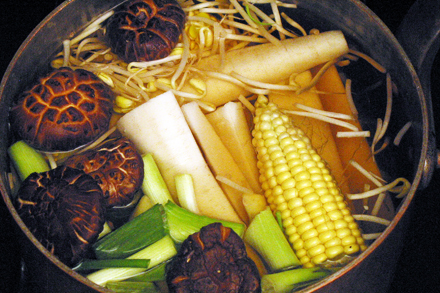
As an open-minded omnivore, I enjoy vegetarian dishes as much as meat dishes. On many occasions I’ve successfully made vegetarian dishes for my vegetarian friends. Many were surprised at the diversity of Chinese vegetarian dishes and commented how flavorful and hearty they were. The key to a rich tasty vegetarian dish is to make use of what is known as umami, which is a Japanese word used to express the fifth taste in addition to the generally accepted four tastes of sweet, salty, sour and bitter. In Chinese umami is known as xian (鮮) and making stock full of umami is the basis for a successful vegetarian dish.
Although the concept of an umami taste did not become commonplace in the West until recently, it has been recognized in Asian culinary culture as a pleasant savory taste for millenniums. In 1908 a Japanese scientist Dr. Kikunae Ikeda of Tokyo Imperial University successfully isolated a glutamate compound from kombu (a type of kelp). The compound is one of the ingredients that can produce umami. He went on to successfully build the Ajinomoto Company extracting and marketing this glutamate, which is known to American as monosodium glutamate or MSG.
MSG has become the flavor enhancer of choice for Asian cooks. Contrary to popular belief there is no scientific evidence that MSG produces unhealthy side effects. In fact, MSG in many different guises such as hydrolyzed proteins, autolyzed yeasts and protein concentrates is pervasive in American food products.
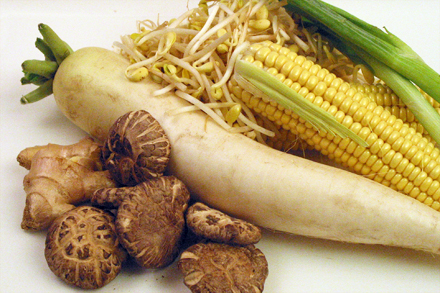
Cooks do not have to use an additive to create umami or xian. This flavor is often produced using natural ingredients. The Chinese character for xian (鮮) consists of two parts. The radical on the left is fish (魚) and the other component is lamb (羊). These two ingredients together were believed to be able to create this ultimate xian flavor. It is well known that animal bones are also excellent sources of umami. They are used in both Asian and Western cooking traditions for enhancing stocks.
Selecting vegetarian ingredients full of natural glutamates can also produce excellent umami for stock. Soybeans, mushrooms and corn are all excellent choices. Soybeans need to be rehydrated before use. Choosing to use soybean sprouts, which are readily available in many Chinatown produce markets, makes it easy to include this ingredient. Dried shiitake mushrooms are also full of umami. Add them directly to the pot. They will rehydrate easily as the stock simmers.
So go ahead and make delicious Chinese vegetarian food. Just remember to make sure you use ingredients that will produce lots of umami.
-
Vegetarian Stock (素清湯)
-
- Preparation time: 10 minutes
- Slow cooking time: 1 hour 30 minutes
-
- 4 cups (12 oz.) soy bean sprouts
- 2 ears fresh corn
- 6 medium dried shiitake mushrooms
- 1 large (1 lb.) daikon radish
- 2 ounces dried kombu (kelp)
- 1 piece 2-inch length of ginger root sliced into thick pieces
- 4 scallions cut into 2-inch length pieces
- 1 cup Shaoxing cooking wine
- 3 quarts water
-
- Put all the ingredients into a large (4 quart) stockpot. Simmer the stock at low heat for about one hour thirty minutes uncovered. The water should reduce to about two quarts. Strain the stock through a very fine sieve and it’s ready for use.



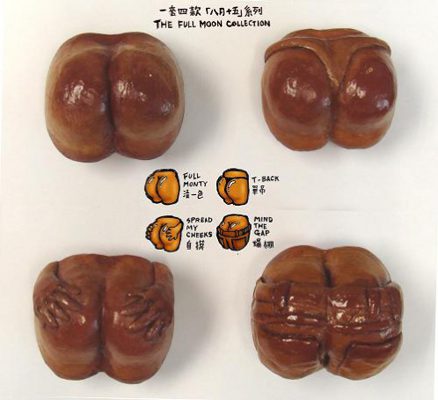
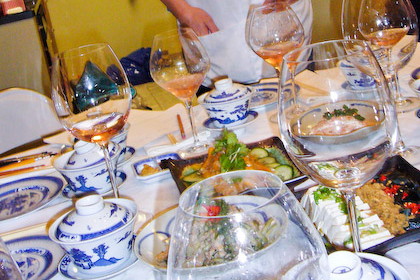
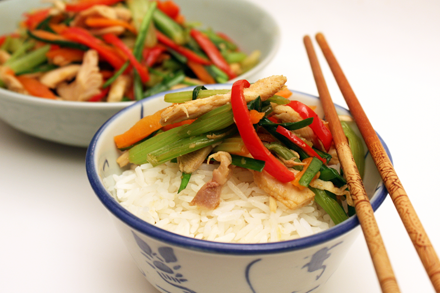
Excellent information to open new concepts to Asian cuisines. I didn’t know about umami 😀
Thanks for sharing and RT in twitter 🙂
All the best,
Gera
Marvelous information! Although I knew a bit about umami, this is the first I’ve learned of it in terms of its place in Chinese cuisine. Thank you, also, for the link regarding the presumed side effects of MSG; these 3 letters have such a negative connotation in Western kitchens that I was quite shocked to see its regular presence on grocery shelves during our visit to my birthplace, the Philippines. I may reconsider its use, if only in very miniscule amounts!
Such nice flavor combinations in this vegetable stock!
Daikon, ginger, and shitake mushrooms always make a wonderful combination.
Great post Kian! Umami is the key to making savory vegetarian dishes. Shiitake mushrooms are a fantastic source. Kombu and dried fish – both of which Japanese use to make dashi – are also excellent sources.
Great post.
Hey, I was just wondering if there would be any posts on Chinese food sculpture. Even a post about which are the good books would be great. Thanks.
(I e-mailed this, but didn’t get a response)
Great post Kian! It’s so funny because I just interviewed the chef at a new vegetarian Japanese restaurant in the east village and have been experimenting with vegetarian stocks. Love the idea of adding corn. Totally makes sense since it’s so high in glutamates.
I made this stock today as a base for a soup, and I have to say it was incredible, so much better than my usual vegetarian stock. I omitted the soy bean sprouts as my husband is mildly allergic and added a tomato in quarters instead, but it was especially the dried shiitake that made everything smell wonderfully, we couldn’t wait to eat! I know I will be using this recipe very, very often from now on.